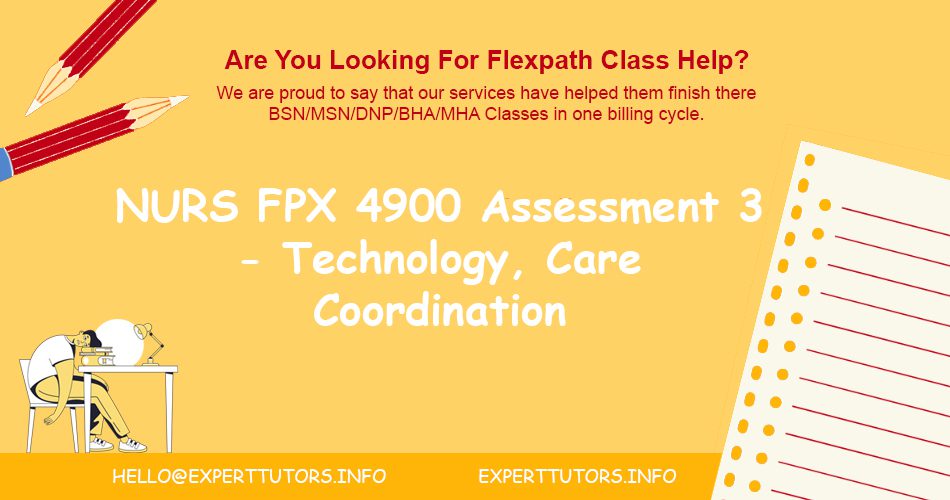NURS FPX 4900 Assessment 3 Technology, Care Coordination, and Community Resources Considerations
Table of Contents
ToggleName: Capella University
NURS FPX 4900
Instructor’s Name
October 2023
Technology, Care Coordination, and Community Resources Considerations
NURS FPX 4900 assessment 3, we explore the range of healthcare options available to a 40-year-old woman coping with the complications of diabetes.
The objective is to identify the crucial points at where community resources, care coordination, and health technology intersect.
We examine their significant consequences for moral professional practice while being guided by the context of organizational and governmental regulations and the ethical requirements of state board nursing practice.
Impact of Technology on Patient
The utilization of health care technology has significantly impacted the management of chronic conditions, such as diabetes, in both individual patients and broader populations.
Technological advancements have introduced a plethora of advantages in terms of improved patient outcomes and quality of care. For instance, the advent of continuous glucose monitoring (CGM) devices has empowered patients’ data on their blood sugar levels (Toschi & Munshi, 2020).
This leads to better glycemic control, reducing the risk of complications associated with diabetes. However, it is imperative to acknowledge that technology is not devoid of disadvantages. The adoption of such devices can be expensive, posing financial barriers to some patients (Toschi & Munshi, 2020).
Additionally, not all patients are technologically literate, which may limit their ability to effectively utilize these tools.
Within professional practice, health care technology has become an integral part of diabetes management.
Electronic health records (EHRs) have revolutionized the coordination of care by providing a centralized platform for healthcare providers to access patient information, including lab results and medication histories (Ganiga et al., 2020).
This enhances the quality and safety of care by minimizing errors related to miscommunication or missing data. Despite these evident advantages, concerns persist regarding data security and privacy in EHRs.
The sharing of sensitive medical information through interconnected systems is accompanied by a potential risk of data breaches (Ganiga et al., 2020). It is critical for healthcare organizations to implement robust security measures to safeguard patient information.
When examining the costs and barriers associated with health care technology, it is evident that while technology can offer remarkable benefits, there are financial considerations and access disparities to address.
For instance, the acquisition of advanced diabetes management technologies, such as insulin pumps or CGM devices, can be cost-prohibitive for some patients without adequate insurance coverage (Susan Gower Smith et al., 2023).
These financial constraints can disproportionately affect underserved populations, exacerbating health disparities.
Moreover, rural communities may face limited access to high-speed internet and telehealth services, impeding their ability to benefit from remote monitoring and telemedicine consultations, despite their potential advantages in reaching underserved populations (Susan Gower Smith et al., 2023).
Health care technology has indeed transformed the landscape of diabetes management, offering numerous advantages in terms of patient empowerment, care coordination, and outcomes.
Nevertheless, it is essential to recognize that these benefits are accompanied by notable drawbacks, such as the financial burden and privacy concerns (Susan Gower Smith et al., 2023).
Therefore, it is incumbent upon healthcare systems to strike a balance between harnessing the potential of technology and addressing the disparities it may introduce. By doing so, healthcare professionals and organizations can optimize the use of technology to enhance diabetes care while mitigating its negative impacts (Susan Gower Smith et al., 2023).
Care Coordination and Utilization of Community Resources
Evidence suggests that effective care coordination facilitates the seamless exchange of information and resources among healthcare professionals, ensuring that the patient receives holistic and continuous care (Johnson et al., 2019).
Professional practice increasingly recognizes the importance of interdisciplinary teams in diabetes management, involving endocrinologists, dietitians, nurses, and behavioral health specialists.
These teams leverage their expertise to develop personalized care plans, leading to improved patient adherence and glycemic control.
However, despite these advantages, barriers may include fragmented healthcare systems, where silos of information and communication gaps persist (Johnson et al., 2019).
Community resources, when effectively utilized, provide invaluable support for individuals with diabetes (Johnson et al., 2019).
These resources can include diabetes education programs, support groups, and access to affordable, healthy food options. For instance, community-based diabetes self-management programs have demonstrated success in improving patients’ knowledge, self-efficacy, and overall health outcomes.
Such programs can develop self-care skills, and establish supportive social networks (Johnson et al., 2019). Nevertheless, challenges may arise due to limited access to these resources in underserved areas and the need for ongoing funding to maintain and expand such community programs.
In current professional practice, care coordination has evolved to include the use of technology to streamline the exchange of patient information, such as Electronic Health Records (EHRs) and telehealth platforms.
These technological advancements have the potential to bridge gaps in communication between healthcare providers, ultimately benefiting patient care (Gibbings & Wickramasinghe, 2020).
Additionally, community health workers are being integrated into care teams to serve as liaisons between healthcare systems and patients in underserved communities, thus enhancing care coordination (Gibbings & Wickramasinghe, 2020).
However, these technologies and workforce enhancements may not be uniformly accessible, leading to disparities in healthcare quality.
Community resources are gaining prominence in diabetes care due to their potential to address social determinants of health, including access to nutritious food and safe physical activity spaces (Johnson et al., 2019).
For example, partnerships between healthcare providers and local grocery stores can promote the availability of healthy food choices in underserved neighborhoods.
Furthermore, community health centers often serve as hubs for comprehensive healthcare services, connecting patients with resources such as nutrition counseling and mental health support.
Nevertheless, funding limitations, variations in resource availability across regions, and transportation challenges can hinder equitable access to these resources (Johnson et al., 2019).
These strategies enhance the quality of care by fostering collaboration among healthcare professionals and providing patients with vital support beyond clinical settings.
While numerous benefits are evident, it is imperative to acknowledge and address the existing barriers, such as communication gaps, funding constraints, and disparities in resource availability.
Nursing Practice Standards and Organizational Policies
State nursing practice standards typically dictate the scope of practice for registered nurses, nurse practitioners, and other healthcare professionals.
In the case of diabetes management, these standards guide the responsibilities, competencies, and ethical considerations for healthcare practitioners (ElSayed et al., 2022).
By adhering to these standards, healthcare providers ensure the safe and ethical application of health technology, such as insulin administration, and coordinate care effectively, thereby protecting patient rights and well-being.
Organizational policies within healthcare institutions, including hospitals and clinics, often further define and supplement state practice standards.
These policies offer practical guidance on the use of technology, and the how to use community resources (ElSayed et al., 2022).
They establish protocols for implementing technology, ensuring patient consent and data privacy.
Furthermore, they guide care coordination by establishing multidisciplinary care teams and communication protocols, ensuring that patient care remains patient-centered. Aligning with these organizational policies fosters ethical and efficient practices within healthcare settings.
Governmental policies and legislative requirements are instrumental in regulating and supporting the ethical application of health technology, care coordination, and community resources.
These policies may include regulations on healthcare technology safety and funding for community resources (e.g., grants for community health programs).
Complying with these policies not only ensures legal and ethical practice but also promotes a standardized, quality approach to healthcare delivery (Ortiz, 2020).
The practicum hours spent engaging with healthcare professionals, patients, and community resources provide real-world insights into the application of these standards and policies.
They offer opportunities to witness how adherence to state nursing practice standards, organizational policies, and governmental policies directly benefits the patient, such as ensuring patient consent before utilizing health technology and promoting the ethical use of community resources (Ortiz, 2020).
These experiences underscore the importance of open communication and collaboration in care coordination.
Conclusion
This assessment underscores the vital role of health technology, care coordination, and community resources in addressing the complex challenges faced by individuals with diabetes, exemplified by our 40-year-old lady.
The ethical underpinning provided by state board nursing practice standards and organizational and governmental policies serves as a compass for healthcare professionals, guiding them towards patient-centered, responsible, and lawful care.
Through the practical experiences documented during practicum hours, we have witnessed the real-world application of these principles, providing valuable insights into the convergence of theory and practice.
As we navigate the dynamic landscape of healthcare, this assessment reinforces the importance of continuing to explore innovative solutions and advocate for policies that promote holistic, ethical, and effective care for individuals and communities alike.
References
ElSayed, N. A., Aleppo, G., Aroda, V. R., Bannuru, R. R., Brown, F. M., Bruemmer, D., Collins, B. S., Hilliard, M. E., Isaacs, D., Johnson, E. L., Kahan, S., Khunti, K., Leon, J., Lyons, S. K., Perry, M. L., Prahalad, P., Pratley, R. E., Seley, J. J., Stanton, R. C., & Gabbay, R. A. (2022). 7. Diabetes technology: standards of care in diabetes—2023. Diabetes Care, 46(Supplement_1), S111–S127. https://doi.org/10.2337/dc23-s007
Ganiga, R., Pai, R. M., M. M., M. P., & Sinha, R. K. (2020). Security framework for cloud based electronic health record (EHR) system. International Journal of Electrical and Computer Engineering (IJECE), 10(1), 455. https://doi.org/10.11591/ijece.v10i1.pp455-466
Gibbings, R., & Wickramasinghe, N. (2020). Technology’s enabling role to improve care coordination. Advances in Healthcare Information Systems and Administration, 358–365. https://doi.org/10.4018/978-1-7998-1371-2.ch027
Johnson, P. J., O’Brien, M., Orionzi, D., Trahan, L., & Rockwood, T. (2019). Pilot of community-based diabetes self-management support for patients at an urban primary care clinic. Diabetes Spectrum, 32(2), 157–163. https://doi.org/10.2337/ds18-0040
Ortiz, M. R. (2020). Patient engagement, nursing theory, and policy possibilities. Nursing Science Quarterly, 33(3), 268–271. https://doi.org/10.1177/0894318420920614
Susan Gower Smith, Ayuk, V., & Scalzo, P. (2023). Barriers to technology adoption by patients and providers in diabetes and hypertension care management. Digital Medicine and Healthcare Technology, 2. https://doi.org/10.5772/dmht.18
Toschi, E., & Munshi, M. N. (2020). Benefits and challenges of diabetes technology use in older adults. Endocrinology and Metabolism Clinics of North America, 49(1), 57–67. https://doi.org/10.1016/j.ecl.2019.10.001








